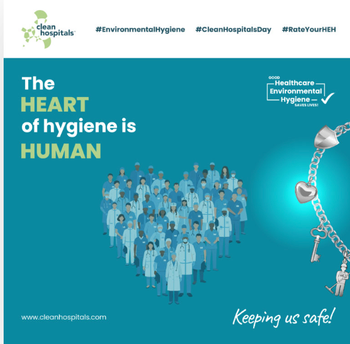
Inside Track With Infection Control Today: Hand Hygiene
Welcome to the Inside Track with Infection Control Today video series, an ongoing series of informational and how-to videos on infection control and prevention topics. This video is about hand washing (soap and water) and hand rubbing (alcohol-based hand rub).
Introducing the Inside Track with Infection Control Today®, an ongoing series of informational and how-to videos on infection control and prevention topics. This video is about hand washing (soap and water) and hand rubbing (alcohol-based hand rub).
In this first video, infection preventionists advise on hand hygiene in general and handling scenarios around hand hygiene.
For viewing time, hand washing and hand rubbing are shortened in this video, but hand hygiene should last at least 20 seconds. See the upcoming Inside Track with Infection Control Today video for a demonstration of the World Health Organization's guidelines on hand washing for a full example.
Transcript and Notes:
Infection Preventionist (IP) #1: Today on Infection Control Today, we will discuss the crucial moments for hand hygiene…hand hygiene can keep you healthy and prevent the spread of infections.
IP #2: There are two primary methods for hand hygiene: alcohol-based hand sanitizer and washing with soap and water. Alcohol-based hand rubs should contain 60%-80% alcohol to be considered effective.
There are different indications for each type of hand hygiene. For example, you should wash your hands with soap and water when your hands are visibly soiled after using the bathroom and for known or suspected exposures to spores such as Clostridioides difficile. Alcohol-based hand sanitizer must be used prior to donning and doffing personal protective equipment (PPE) and before contact with a patient, in their environment.
[See the
IP #1: According to
Glove use requires the same amount of hand hygiene as without gloves. Gloves should be changed before donning and after doffing PPE, and before performing an aseptic procedure, such as an injection giving eyedrops, and for all of the WHO's 5 moments for hand hygiene.
Scenario #1:
Health care worker donning PPE without performing hand hygiene first.
IP: my name is Cheryl. I'm from infection prevention. I see you're putting them first. Unfortunately, hand hygiene, we need to do that first.
Health care worker: Why do we need to clean our hands? I am putting on gloves to protect my hands.
IP: That's a good question. Well, gloves aren't a suitable replacement for hygiene. If your hands are dirty when caring for your patient and your gloves are torn, you risk transmitting organisms to your patient.
[Gloves are not a substitute for hand hygiene; you should always perform hand hygiene before donning and after doffing gloves. Although many people believe gloves remove the need for hand hygiene, it does not.Gloves use will require precisely the same amount of HH actions as without gloves. Before donning gloves is the “before patient” indication. If you touch a dirty body site, you must do hand hygiene before moving to a clean one. If you must perform an aseptic procedure, such as an injection or giving eyedrops, the gloves must be changed, and HH should be performed now. All the World Health Organization’s
Scenario #2:
Health care worker come from another patient's room without cleaning their hands first.
IP: Hi, my name is Isis. I am with infection control. Remember to perform hand hygiene before and after contact with a patient and their environment Most hospital-acquired infections are passed through contaminated hands.
Health care worker: Thank you!
[It is recommended to keep hand sanitizer dispensers at the patient's bedside and in standardized locations to encourage adherence. It is also helpful to place dispensers near clean gloves to encourage hand hygiene before donning gloves. If needed, reach out to your hand sanitizer provider to see what size refills can fit your dispensers.]
Scenario #3:
Health care worker steps out of Clostridiodes difficile room and wash their hands with soap and water.
IP: Thank you for washing your hands with soap and water. This is a room with a patient with C diff, and Alcohol-based hand sanitizer is ineffective in killing C diff spores. I appreciate you following the right protocols.
[Check with your facility’s guidelines whether you are allowed to leave a patient’s room in full personal protective equipment. When entering a room with a patient with C diff, the health care workers hair should be up, and they should have on little to no jewelry.]
Hand hygiene and artificial nails:
IP #1: We hope these scenarios were beneficial in reviewing best practices for hand hygiene and preventing infections.
IP #2: It is recommended that health care workers do not wear artificial nails when having direct contact with patients.
IP #3: Health care workers should also avoid chipped nail polish.
IP #1: Artificial nails, chipped polish, and nails over 1/4 inch can harbor pathogens and act as conduits for disease transmission. Various epidemiologic investigations have traced health care-acquired infections to contaminated fingernails.
IP #2: Artificial nails, chipped nails, and gel-based nail polish have a higher bacterial load than natural and unchipped nails. This is due to additional surfaces for microbes to adhere to and making it challenging to remove microbes on these surfaces. It is important to partner with managers as they can hold their team members accountable.
IP #3: It is also import to establishing nail expectations in your facility's hand hygiene policy and discuss with your staff requirements during orientation is important. Also, remind staff to clean their skin underneath rings, jewelry, and watches.
IP #1: Areas that are frequently missed during hand hygiene are the thumbs, fingertips, and between fingers. Jewelry is not recommended in specific areas such as the operating room and the sterile processing department.
[Jewelry and watches are not recommended in patient care full stop. “The consensus recommendation is to strongly discourage the wearing of rings or other jewelry during health care. If religious or cultural influences strongly condition the HCW’s attitude, the wearing of a simple wedding ring (band) during routine care may be acceptable, but in high-risk settings, such as the operating theatre, all rings or other jewelry should be removed,” according to the WHO Guidelines on Hand Hygiene in Health Care.
IP #2: Use only hand lotions approved by your facility that will not interfere with hand hygiene products.
IP #3: Always keep your hands clean and remind staff to perform hand hygiene to protect patients and others from infections.
[It is important to keep using lotions and creams to prevent skin dryness caused by frequent hand hygiene, although using alcohol-based hand rub is far less damaging to the skin than frequent washing.]
All IPs: Clean hands save lives!
Infection Control Today welcomes ideas for future videos. If you have suggestions, please email
Newsletter
Stay prepared and protected with Infection Control Today's newsletter, delivering essential updates, best practices, and expert insights for infection preventionists.





